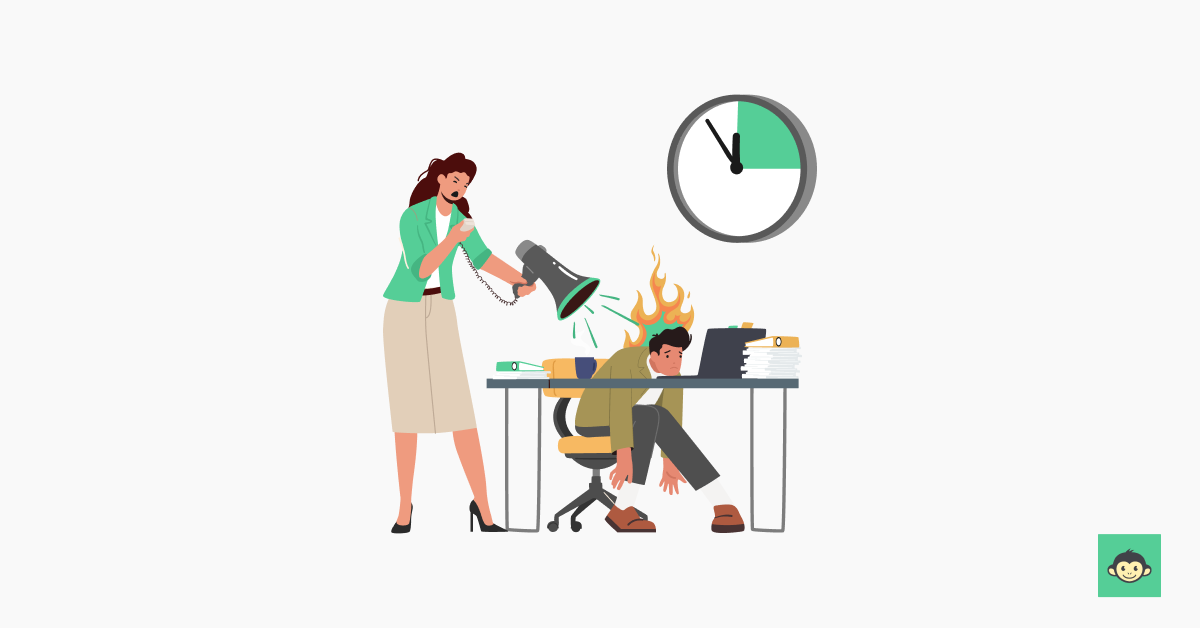How to prevent harassment in the workplace: Building a positive culture for employees

Imagine a workplace where everyone feels comfortable, respected, and empowered to do their best work. Sounds pretty idyllic, right? But unfortunately, the reality for many employees is far from this utopia.
Harassment, in all its various forms, can create a toxic work environment that impacts not only employee well-being but also productivity and your company's bottom line.
As a leader, you have a responsibility to cultivate a safe and inclusive space for your team. But how do you prevent harassment before it happens? In this blog, we'll delve into the top strategies and best practices you can implement to create a workplace free from harassment, focusing on both sexual harassment and general workplace harassment.
We'll cover everything from establishing clear policies to fostering a culture of respect and open communication. By taking a proactive approach, you can ensure your employees feel valued, protected, and empowered to thrive.
What is harassment in the workplace?

Harassment in the workplace refers to any unwanted or unwelcome behavior that affects an individual's dignity, makes them feel intimidated, offended, or humiliated, and creates an uncomfortable or hostile work environment. This behavior can take many forms, including but not limited to:
- Sexual harassment: Unwanted advances, requests for sexual favors, or other verbal or physical conduct of a sexual nature.
- Discriminatory remarks: Comments or actions that target an individual's race, gender, age, religion, disability, or other protected characteristics.
- Bullying: Persistent and unwanted aggressive behavior towards an individual, which can be verbal, physical, or psychological.
- Inappropriate behavior: Actions or comments that are not suitable for the workplace environment, such as offensive jokes, derogatory remarks, or disrespectful gestures.
- Retaliation: Negative actions taken against an individual for reporting bad behavior and harassment or participating in harassment prevention efforts.
- Hostile work environment: A workplace atmosphere where harassment occurs frequently, making employees feel unsafe, uncomfortable, or unable to perform their job effectively.
Harassment can occur between coworkers, between a supervisor and an employee, or even between employees and clients or customers. It is essential to understand that harassment is not limited to any specific gender or role; anyone can be a victim, and anyone can be a perpetrator.
In many cases, harassment may be subtle and may not always involve direct confrontation. It can manifest through text messages, emails, or other forms of communication, making it challenging to identify and address.
Is harassment and bullying the same?

Harassment and bullying are related concepts but not exactly the same. While both involve unwanted or unwelcome behavior that can create a hostile or uncomfortable work environment, there are distinctions between the two:
Harassment:
- Legal definition: Harassment is often defined by law and can include behaviors that are discriminatory or violate protected rights based on race, gender, age, religion, disability, or other characteristics.
- Specific types: Includes sexual harassment, workplace harassment, and discriminatory remarks.
- Intent: Harassment can be intentional or unintentional, and it often involves a pattern of behavior rather than isolated incidents.
- Legal consequences: Harassment can lead to legal issues, including lawsuits, if not addressed appropriately by employers.
Bullying:
- General behavior: Bullying is a broader term that refers to aggressive or hostile behavior directed towards an individual, often with the intent to intimidate, humiliate, or control.
- Types: Can include verbal, physical, or psychological bullying, and is not limited to specific protected characteristics.
- Environment: Bullying can create a hostile work environment, similar to harassment, but it may not always be based on discrimination or protected rights violations.
- Intent: Bullying is often intentional and may be more personal or targeted towards an individual rather than based on a specific characteristic.
- Consequences: While bullying can also have serious consequences and can lead to harassment, it may not always have the same legal ramifications as harassment unless it involves discrimination or violates specific laws or company policies.
What 3 factors determine workplace harassment?

While harassment can take various forms and manifest in different ways, there are three primary factors that often determine its presence in the workplace.
Delving into these factors—ranging from inappropriate behavior to discrimination and the creation of a hostile environment—can provide valuable insights for employers and employees alike.
- Inappropriate behavior: One of the most evident signs of harassment is inappropriate behavior that is unwanted or unwelcome. This can manifest as actions, comments, or gestures that make an employee feel uncomfortable, intimidated, or offended. Such behavior may include unwelcome advances, offensive jokes, or derogatory remarks targeting an individual or a group based on their characteristics or affiliations.
- Discrimination and discriminatory remarks: Harassment often involves discrimination where individuals are targeted based on their race, gender, age, religion, disability, or other protected characteristics. Discriminatory remarks, comments, or actions that demean or belittle someone because of their identity are clear indicators of harassment. These remarks create a hostile environment and contribute to the harassment culture within the workplace.
- Creation of a hostile work environment: Harassment leads to the creation of a hostile or offensive work environment where employees feel unsafe, uncomfortable, or marginalized. This hostile environment is often characterized by a pattern of ongoing harassment incidents, discriminatory behavior, or inappropriate actions that interfere with an individual's ability to perform their job effectively. It can also include the spread of rumors, exclusionary practices, or any behavior that isolates or intimidates employees.
Recognizing these detailed factors—inappropriate behavior, discrimination, and the creation of a hostile work environment—is crucial for employers to effectively identify and address workplace harassment.
By understanding these factors in depth, organizations can take proactive measures to prevent harassment, protect their employees, and promote a culture of respect and inclusivity in the workplace.
What are the types of workplace harassment?
Understanding the different types of workplace harassment is crucial for creating a safe and respectful environment for all employees. Here's a detailed look at some of the types of workplace harassment:
Sexual harassment
Sexual harassment cases involves unwanted sexual advances, requests for sexual favors, or other verbal or physical conduct of a sexual nature. This can also encompass creating a hostile work environment based on someone's gender or sexual orientation, where offensive comments, jokes, or visual materials of a sexual nature are present and contribute to discomfort or intimidation.
Verbal harassment
Verbal harassment includes derogatory remarks, insults, or offensive comments targeting an individual's race, religion, gender, age, or other protected characteristics. It can also involve spreading rumors or gossip that tarnishes someone's reputation, creating a negative atmosphere and affecting an individual's self-esteem and well-being.
Non-verbal harassment
Non-verbal harassment involves gestures, visual displays, or physical actions that are offensive or inappropriate. This is also considered harassment and can range from lewd gestures or facial expressions to displaying offensive images, posters, or materials in the workplace, creating discomfort and contributing to a hostile environment.
Psychological harassment
Psychological harassment includes actions or comments that are intended to intimidate, humiliate, or control an individual mentally or emotionally. This can include threats, bullying, or undermining someone's self-esteem and confidence through persistent negative interactions and behaviors.
Cyber harassment
Cyber harassment occurs online or through digital platforms and includes sending offensive emails, text messages, or social media posts intended to harass or intimidate someone. This form of harassment can extend the workplace environment into the digital realm, causing distress and affecting an individual's mental well-being.
Discriminatory harassment
Discriminatory harassment targets individuals based on their race, gender, age, religion, disability, or other protected characteristics. It involves treating someone unfairly or differently because of their identity, which can lead to exclusion, marginalization, and a feeling of being undervalued or discriminated against.
Mobbing
Mobbing is a form of harassment where a group of individuals targets and harasses a single person. It can include spreading rumors, excluding the person from activities, or any behavior that isolates and intimidates the individual. Mobbing can have serious psychological effects on the victim, leading to stress, anxiety, and a decline in mental health.
Recognizing these detailed types of workplace harassment is essential for organizations to develop comprehensive policies, training programs, and procedures to prevent and address these behaviors effectively.
By understanding the nuances of each type of harassment, employers can take proactive measures to create a respectful and safe workplace environment for everyone.
How remote harassment differs from in-person harassment?

Navigating the digital landscape has brought about new challenges in preventing workplace harassment, including the emergence of remote harassment. While in-person harassment and remote harassment share similarities, they also have distinct differences that employers and employees should be aware of.
Let's delve into how remote harassment differs from in-person harassment:
- Digital distance: Unlike in-person harassment, remote harassment occurs in a digital environment, often through email, video calls, instant messaging, or social media platforms. This digital distance can make it easier for perpetrators to hide behind screens and commit acts of harassment anonymously, making it challenging to identify and address the issue.
- 24/7 accessibility: With remote work, the boundaries between work and personal life can blur, most cases leading to constant accessibility. This can result in employees receiving harassing messages or emails outside of traditional work hours, invading their personal time and space, and causing added stress and anxiety.
- Virtual environments: Virtual meetings and conferences can become platforms for harassment, with perpetrators using disruptive behavior, inappropriate comments, or sharing offensive content during video calls. This form of harassment can create a hostile virtual environment, affecting participants' engagement and well-being.
- Digital evidence: Remote harassment often leaves a digital trail, with perpetrators leaving behind evidence such as emails, chat logs, or screenshots. While this can make it easier to document and to report incidents of the person harassing you, it also raises concerns about data privacy and cybersecurity, requiring organizations to handle and protect sensitive information carefully.
- Tech-savvy tactics: Perpetrators of remote harassment may use tech-savvy tactics, such as hacking into someone's account, creating fake profiles to harass individuals anonymously, or using bots to send harassing messages. This form of harassment can be more sophisticated and challenging to combat, requiring advanced cybersecurity measures and employee awareness.
- Isolation and loneliness: Remote work can contribute to feelings of isolation and loneliness, making victims of harassment feel more isolated and less supported. Without the physical presence of colleagues and supervisors, victims may hesitate to report harassment, fearing retaliation or not being taken seriously.
Recognizing these differences between remote harassment and in-person harassment is crucial for organizations to develop strategies and policies that address both effectively.
Negative effects of workplace harassment that affect company culture

Workplace harassment can have profound negative effects that extend beyond the individuals directly involved, impacting the overall company culture. Here's a closer look at how workplace harassment affects company culture:
- Erosion of trust: Workplace harassment undermines trust among employees. When employees witness or hear about harassment incidents and see that they are not addressed or taken seriously, it erodes trust in management and the employer or organization's commitment to a safe and respectful work environment.
- Decreased morale: Harassment can lead to low morale among employees. Victims of harassment often experience stress, anxiety, and reduced job satisfaction, while bystanders may feel demotivated and disillusioned by the toxic environment. This can lead to decreased productivity and engagement levels across the organization.
- Increased turnover: Employees who experience harassment are more likely to leave the organization, leading to increased turnover rates. High turnover not only disrupts team dynamics but also increases recruitment and training costs, affecting the organization's stability and long-term success.
- Negative reputation: A workplace known for harassment can damage the company's reputation both internally and externally. This can make it difficult to attract and retain top talent, as well as to build strong relationships with clients, partners, and stakeholders who prioritize ethical and inclusive business practices.
- Lack of diversity and inclusion: Harassment can create a hostile environment that discourages diversity and inclusion. Employees from diverse backgrounds may feel unwelcome or marginalized, leading to a lack of diverse perspectives and ideas within the organization. This can hinder innovation, creativity, and adaptability, limiting the company's growth potential.
- Legal risks and financial costs: Ignoring or mishandling sexual harassment cases and complaints can expose the company to legal risks, including lawsuits, fines, and reputational damage. The financial costs associated with legal fees, settlements, and damage control can be significant, impacting the company's bottom line and sustainability.
- Decreased customer trust: A negative company culture resulting from harassment can also affect customer trust. Customers prefer to engage with companies that demonstrate integrity, respect, and ethical conduct. A company known for harassment may lose customer trust and loyalty, affecting sales, customer retention, and long-term business relationships.
- Stifled innovation and collaboration: In a culture where harassment is tolerated, employees may hesitate to speak up, share ideas, or collaborate openly. This can stifle innovation, creativity, and collaboration, hindering the organization's ability to adapt to changing market conditions and stay competitive.
Understanding these negative effects of workplace harassment on company culture is crucial for organizations to take proactive measures to prevent and address harassment effectively.
Why is harassment prevention important as a leader?

Preventing workplace harassment is crucial for leaders to prioritize and champion within their organizations. Here's why harassment prevention is important as a leader:
- Fostering a positive work environment: Leaders have the responsibility to create a workplace where employees feel safe and respected. Implementing an effective anti harassment policy, and working on prevention efforts helps in cultivating a workplace free from workplace harassment and sexual harassment. This promotes a positive and inclusive environment for all employees.
- Protecting employees: Harassment, including sexual harassment issues and workplace harassment, can make employees feel unsafe and harassed. As leaders, it's crucial to protect the well-being and dignity of all workers by taking proactive measures to prevent harassment and ensure a hostile work environment is not tolerated.
- Legal and reputational risks: Ignoring or mishandling harassment can expose employers and managers to legal issues, including lawsuits and fines. Furthermore, a negative company culture resulting from harassment can damage the company's reputation, affecting its ability to attract and retain talent and build strong relationships with clients and stakeholders.
- Promoting respect and inclusion: Harassment prevention is not just about avoiding negative behaviors; it's also about promoting respect, inclusion, and diversity within the organization. Leaders who prioritize harassment prevention demonstrate a commitment to creating a respectful and inclusive workplace where all employees, regardless of their background or identity, are valued and treated with dignity.
- Creating clear policies and processes: Implementing effective anti-harassment policies and establishing a clear complaint process empowers employees to report harassment and harassment incidents without fear of retaliation. This transparency and accountability foster trust and confidence among workers that complaints will be taken seriously and addressed promptly.
- Educating and training (especially on sexual harassment): Providing training programs on workplace sexual harassment prevention and workplace harassment equips employees and supervisors with the knowledge and skills to recognize, preventing sexual harassment. This sexual harassment prevention training ensures everyone is aware of appropriate behavior and understands the consequences of engaging in bad behaviors.
- Maintaining professionalism: Harassment undermines professional conduct and behavior within the organization. As leaders, it's essential to set clear expectations for professional behavior and ensure that harassment and inappropriate behavior are not tolerated.
What are the essential steps for preventing harassment in the workplace?

Preventing harassment in the workplace requires a comprehensive approach that involves proactive measures, clear policies, and ongoing training. Here are essential steps to prevent harassment:
Develop and implement anti-harassment policies
Create clear, comprehensive, and accessible anti-harassment policies that define harassment, outline prohibited behaviors, and establish reporting procedures. Ensure these policies are communicated to all employees and are readily available in employee handbooks, on intranet portals, and posted in common areas.
Provide regular sexual harassment training and sexual harassment prevention training
Conduct regular sexual harassment training sessions for employees and supervisors on harassment prevention, emphasizing the importance of respect, inclusion, and appropriate workplace behavior. Training should cover recognizing different forms of harassment, understanding the impact on victims, and the consequences for engaging in harassing behaviors.
Establish a clear reporting process
Implement a confidential and accessible process for employees to report harassment, including multiple reporting options such as reporting to a supervisor or supervisors, HR, or a designated neutral party. Ensure employees are aware of their rights and protections against retaliation for reporting harassment.
Promptly investigate and address complaints
Take all harassment complaints seriously and initiate a prompt, thorough, and impartial investigation. Ensure investigations are conducted by trained individuals or external professionals to maintain confidentiality and integrity. Take appropriate disciplinary actions against perpetrators based on investigation findings.
Promote a culture of respect and inclusion
Foster a workplace culture that values respect, diversity, and inclusion. Encourage open communication, mutual respect, and collaboration among employees. Leaders and managers should model positive behaviors and address disrespectful or discriminatory behaviors proactively.
Provide support for victims
Offer support and resources to employees who experience harassment, including counseling services, employee assistance programs, and access to legal advice. Ensure victims are aware of available support and are protected from further harassment or retaliation.
Monitor and evaluate prevention efforts
Regularly review and evaluate harassment prevention efforts to assess their effectiveness and identify areas for improvement. Collect feedback from employees through surveys or focus groups to gauge perceptions of the workplace environment and policies.
Enforce consequences for harassment
Clearly communicate the consequences for engaging in harassment, which may include disciplinary actions up to and including termination. Ensure all employees are aware that harassment will not be tolerated and that all reports will be taken seriously and addressed promptly.
Stay updated on laws and regulations
Stay informed about federal, state, and local laws and regulations related to harassment prevention. Ensure policies and practices comply with legal requirements and adapt to changes in laws as necessary.
Role of DEI surveys in preventing harassment at work

Diversity, equity, and inclusion (DEI) surveys play a crucial role in preventing harassment at work by providing insights into the organization's current culture and identifying potential issues related to harassment and discrimination.
These surveys allow organizations to gather anonymous feedback from employees, encouraging honest and candid responses without fear of retaliation.
Based on the insights from DEI surveys, organizations can develop targeted interventions, such as additional training or policy revisions, to address specific issues and foster a more respectful and inclusive workplace.
By regularly conducting DEI surveys, organizations can track progress over time, measure the effectiveness of their efforts, and hold leaders accountable for promoting DEI and maintaining a harassment-free environment.
Involving employees in DEI surveys demonstrates a commitment to valuing their input and creating an inclusive workplace. This engagement fosters a sense of ownership and collective responsibility among employees in preventing harassment and promoting a positive workplace culture.
Additionally, transparent communication about the purpose, process, and outcomes of DEI surveys helps build trust among employees. When employees see that their feedback is taken seriously and leads to meaningful action, they are more likely to trust the organization's commitment to preventing harassment and promoting DEI.
By integrating DEI surveys into their broader harassment prevention and DEI initiatives, organizations can create a more respectful, inclusive, and harassment-free workplace where all employees can thrive.
Conclusion
We hope this blog has highlighted the importance of proactive measures, clear policies, and ongoing training in preventing harassment in the workplace for you effectively. By adopting a comprehensive approach that prioritizes diversity, equity, and inclusion, organizations can foster a culture that values respect, collaboration, and mutual respect among employees. Remind your employees to call out bad behavior.
Allow us to help - CultureMonkey is deeply committed to building safer spaces by prioritizing diversity, equity, and inclusion (DEI) through regular DEI surveys and targeted interventions.
Through transparent communication, engagement, and accountability, CultureMonkey fosters a culture where all employees feel valued, respected, and empowered to contribute to a respectful and harassment-free workplace.
FAQs
1. What are the essential steps for preventing harassment in the workplace?
Essential steps for preventing harassment in the workplace include developing clear anti-harassment policies for the company, providing regular training on harassment prevention, establishing a confidential reporting process, promptly investigating complaints, promoting a culture of respect and inclusion, offering support for victims, monitoring prevention efforts, enforcing consequences for harassment, staying updated on laws, and encouraging open communication.
2. What five 5 preventive actions can a company take and use as a defense against harassment?
Companies can develop comprehensive anti-harassment policies, conduct regular training programs, establish a confidential reporting process, promptly address complaints, and enforce consequences for harassment. These detailed processes and preventive actions can foster a respectful workplace culture and serve as a defense against potential harassment claims by demonstrating proactive efforts to prevent and address harassment effectively.
3. What are the 3 benefits of being aware and taking steps to prevent workplace harassment?
Being aware and taking steps to prevent workplace harassment at the workplace promotes a culture that is respectful and inclusive. It minimizes legal risks, and boosts both employee morale and productivity. By fostering a harassment-free environment, organizations create a positive workplace where employees feel valued, respected, and empowered to succeed, contributing to overall organizational success.
4. How can management prevent discrimination and harassment in the workplace?
Management can prevent discrimination and harassment by promoting a culture of respect and inclusion, providing regular training on diversity and inclusion, establishing clear policies and procedures for reporting and addressing complaints, enforcing consequences for discriminatory behavior, and fostering open communication among employees. Leaders should model positive behaviors and address issues proactively to create a safe workplace for all employees.



